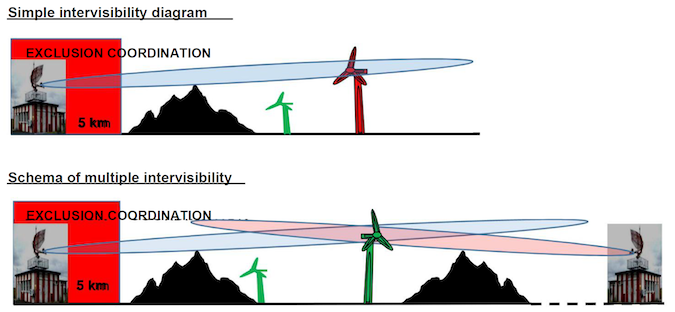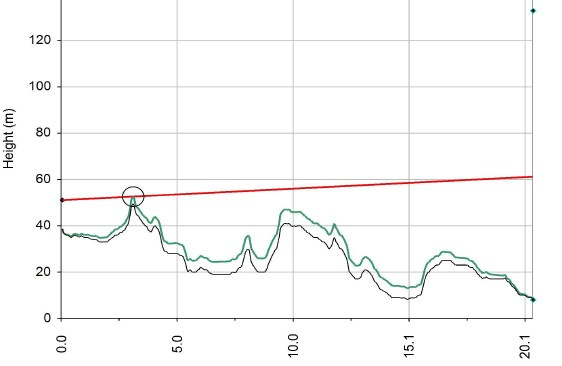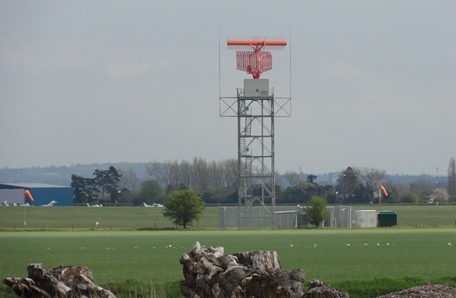In this article, we take a look at the repealed assessment criteria set out by the French Military to determine the viability of a wind farm with respect to the potential impact upon military radar infrastructure in France. We also compare it to Pager Power’s recommended methodology for the assessment of French military radar. The Ministère des Armées (Ministry of Armed Forces) is the key stakeholder that safeguards military radar in France.
Repealed French Military Criteria
There are two documents that are relevant to wind farm radar issues in France; these are ‘INSTRUCTION N°1050/DSAÉ/DIRCAM’ and ‘INSTRUCTION N°1051’ [1]. The French military guidance on radar infrastructure (N° 1050) has since been repealed (in N°1051) as of the 16th of June 2021. There is no official replacement for this guidance. However, Pager Power is in frequent discussions with French wind developers having completed various radar impact assessments, and understands that at least one of the criteria (intervisibility) within the guidance is still applied by the French military in practice. Below, we discuss the repealed guidance in full.
‘Radioelectric Servitudes And Constraints On The Supplement 4 – Terms Of Processing Files Under The Title Radars Des Armees’ contains the relevant criteria within instruction N°1051. Within this section of the document, two appendices are of relevance:
- ‘Appendix 1: radars’.
- ‘Appendix 2: transitional criteria’.
Appendix 1: Radars – Acceptability Criteria
There are two main criteria in Appendix 1, the ‘Acceptability Criteria’ and ‘Case of Sensitive Sites’.
For the acceptability criteria, multiple electromagnetic intervisibility is a critical requirement. What this means in simple terms is that if one French military radar has a line of sight ‘visibility’ to a proposed wind turbine, then another military radar is required to have ‘visibility’ as well. This is shown in the figure below.
Figure 1: Multiple intervisibility.
For radar infill mitigation, a scenario in which one radar is affected by a wind development (turbines are within radar line of sight) and another radar is unaffected (turbines are not within radar line of sight) but has low-level coverage above a wind development is typically the ideal scenario in the UK and internationally. However, with the French military intervisibility scenario, turbines which are in a line of sight to two or more radar is preferable. The criteria are set out in the table below. It is understood that whilst the guidance as a whole has been repealed, the French military still considers intervisibility to be their key criterion.
Table 1: French military safeguarding criteria.
Appendix 1: Radars – Case of Sensitive Sites
The ‘Case of Sensitive Sites’ criterion is applied to prohibited zones, certain air bases and other locations which are more robustly safeguarded. The criterion states that when a sensitive site is located within 30km of military radar, the guarantee of optimal detection in this area requires a case-by-case study by radar operators for any obstacle in electromagnetic intervisibility. It is our understanding that consideration of sensitive sites within 30km of radar should be identified but it is not understood whether this criterion is still considered. The figure below illustrates this criterion.
Figure 2: Case of Sensitive Sites.
Appendix 2: Transitional Criteria (Angular Criteria)
It is understood that the transitional criteria were applied to wind developments that were in the system for the French Military’s consideration before the intervisibility criteria were introduced.
The guidance states that for any military radar within 30km, no wind developments should be within a 5-degree azimuth range of each other. Furthermore, any proposed wind development should remain within a 1.5-degree azimuth range relative to a radar. The figure below illustrates these criteria.
Figure 3: Transitional Criteria (Angular Criteria).
Following further discussion with wind developers in France, it is understood that the French Military no longer considers the transitional criteria.
Pager Power’s Recommended Methodology – Radar Impact Assessment for Primary Surveillance Radar
In addition to the assessment of the relevant French military criteria, Pager Power also includes an assessment in line with our own recommended methodology for French Military radar. It is set out in the following parts:
- Radar line of sight Assessments – which determine how much of a turbine is illuminated by the radar signal.
- Assessment of the predicted impact in the context of the existing environment.
- Radar detectability analysis – which determines the likelihood of a turbine being displayed on a radar screen.
- An assessment in line with Eurocontrol Guidance ‘Guidelines how to assess the potential impact of wind turbines on surveillance sensors – Ed. 1.2’ [2]. This includes assessment of PSR shadowing and false target reports. It is important to note that France is one of 41 member states of Eurocontrol.
- Where there is a potential technical impact, an evaluation of the associated operational or cumulative impact.
- An overview of mitigation options is then explored (where appropriate).
There are a number of radar mitigation options that can be explored. If objections are sustained, the provision of a ‘compensation radar’ is the mitigation method that is sometimes preferred by the French military. Pager Power also has extensive experience in undertaking further studies to determine the locations that would be most suitable for a new radar. Our detailed bespoke analysis has been appreciated for its value to both the French military and wind developers.
The Future of French Military Radar?
The French Military has informed wind developers that their radar will be replaced in the next few years. These radar could have a range of over 70 km and with three options for the antenna height. Pager Power includes an assessment at the different heights within our reports to allow for consideration of the future radar.
Conclusions
Pager Power has significant experience in undertaking radar impact assessments internationally, including in France, having supported various French wind developers. The criteria that the French military set out in INSTRUCTION N°1051 have since been repealed. However it is understood that at least the acceptability criteria (i.e. multiple intervisibility) is still a key consideration of the French Military when determining the acceptance of wind developments. Pager Power recommends an additional assessment approach whereby intervisibility cannot be met. This includes radar detectability analysis and the assessment of shadowing and false target reports, which is in line with the approach recommended by Eurocontrol, of which France is a member state.
One approach is to try to meet the French military requirements where possible. Where this is not possible, developers may seek our advice on a compensation radar study to provide sufficient mitigation. A different approach is to contest an objection supported by an assessment approach that involves detailed analysis in line with Eurocontrol guidance.
Pager Power
Pager Power is a dedicated technical consultancy that has been providing independent guidance and advice regarding solar developments, wind farms, and building developments internationally since 2002. Further details about what services we can provide can be found here. Pager Power has completed over 1,300 glint and glare assessments, over 1,000 aviation/radar impact assessments, over 500 television and radio reception surveys, and over 500 telecommunications impact assessments.
If you require assistance for one of your projects, please get in touch on our website or call us on +44 (0)1787 319001.
References
[1] https://www.dircam.dsae.defense.gouv.fr/index.php/fr/lien-utile/instructions-dircam#inst-150-1650
[2] https://www.eurocontrol.int/publication/eurocontrol-guidelines-assessing-potential-impact-wind-turbines-surveillance-sensors
Thumbnail image accreditation: Wind farm near Caen, Normandie (2008) from wikicommons. Last accessed on 26th June 2024. Available at: https://commons.wikimedia.org/wiki/File:%C3%89oliennes_Caen.jpg







